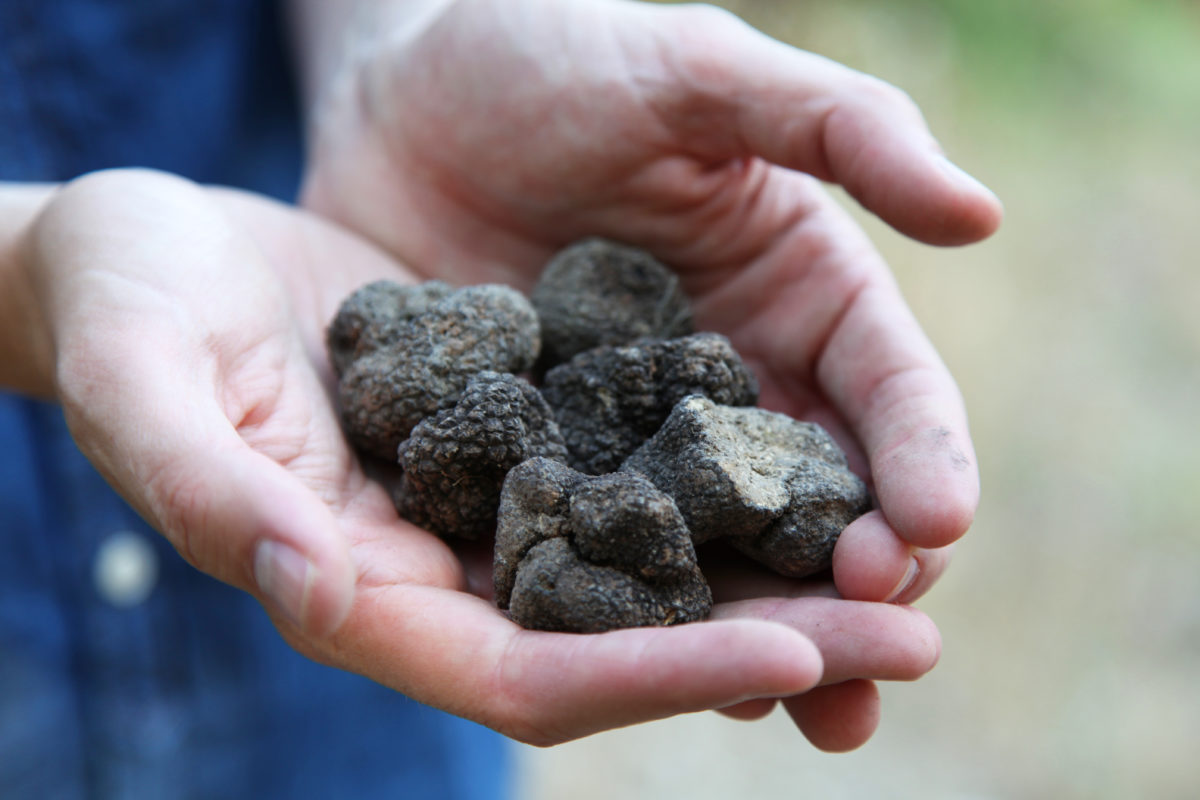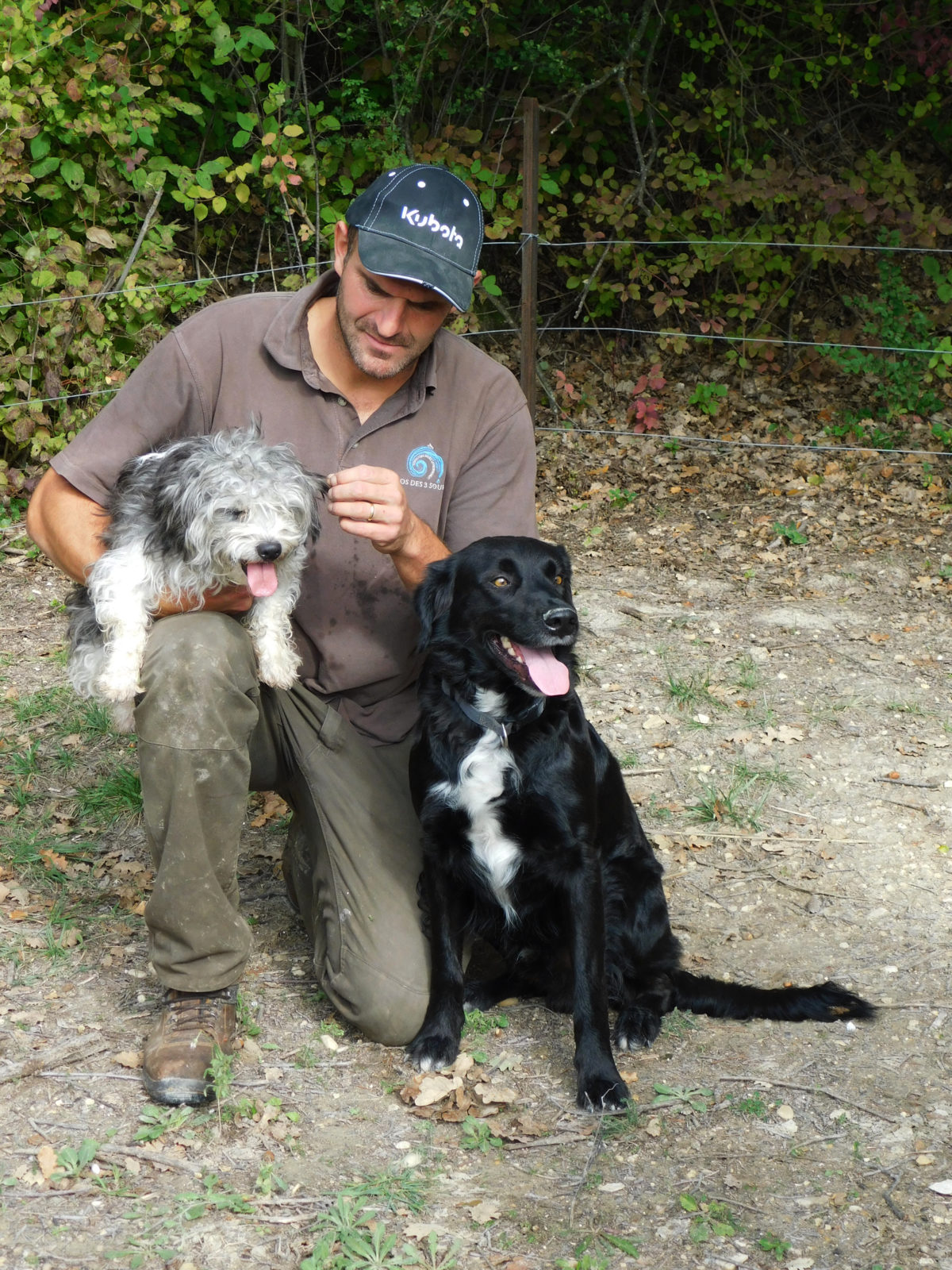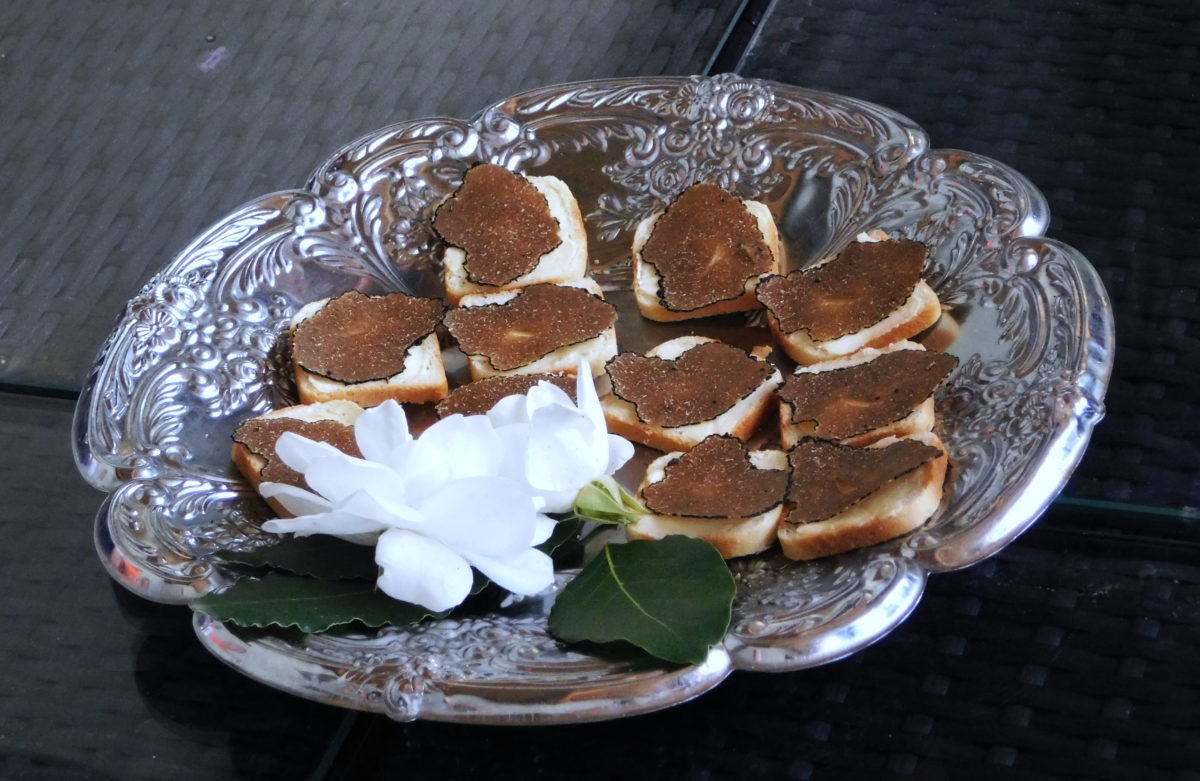
By : Alexandra Shuman
“I never wanted to be a farmer.” Straw-hatted and heavy-booted, Johann is first and foremost a businessman. Not an inch of the farm he inherited from the grandparents who raised him is untouched by his entrepreneurial hustle, the kind you expect to find in New York or Silicon Valley. And yet, here it is at the end of a Provencal dirt road. His smile was laced with satisfaction when I brought it up, “Famers should do a year of marketing, a year of finance, and then learn how to plant stuff. On our farm, we don’t depend on our truffles. If the ground freezes, our truffles are useless. We have olive trees, bees, tours, and activities.” If his mind belongs to business, his heart belongs to the ground. Or rather, what lies beneath it.
Starting a truffle farm from scratch requires two things: perfect conditions and a hell of a lot of patience. The summers must be hot, but not too hot. The winters cold, but not too cold. A little rain, but not too much. A young oak or hazelnut tree must be inoculated with truffle spores and planted in alkaline soil with excellent drainage. Once all of this is in place, only one thing stands between farmer and truffle: a decade.
“The spores put us one step ahead of nature,” Johann spoke matter-of-factly. “It’s easy to grow a tree, but for ten years there’s no way to tell if the spores are alive. I’ve planted about 1,000 oak trees on my property and only 30% produce truffles.” At $20-$25 per inoculated sapling, I was beginning to understand why truffles are so expensive. Seeking a silver lining, I asked, “Once you find truffles, will they grow for the rest of that tree’s life?”
“You’ll get truffles for several decades if you do the job right,” pride bolstered his words. “The difficult thing is to get started.” Johann was interrupted by a dog barreling between his legs. Éclair, the spirited young border collie-lab mix, was followed by an ambiguous and bumbling ball of fur. “Mirabelle! She’s been truffle hunting for eleven years. The best in the business.” Both mutts began truffle-training at two months old.
“Ah, the ol’ truffle in a tennis ball trick, huh?”
Johann chuckled, “Yes! First you build the association with fun, and then with reward. We play hide and seek around the house, then outside, then remove the tennis ball, then start burying the truffle. Eventually, they’re digging up truffles and bringing them right to you. We give them the good stuff: prosciutto, sausage, ham.” He told the story of a farmer’s son getting upset that their truffle dogs ate so well. The farmer’s response? “When you start finding truffles, you’ll eat like this, too!”
It takes time to train truffle dogs, but it’s worth it for farmers who want to keep their fingers intact and their businesses thriving. While pigs forage truffles by nature, they also want to eat them as much as we do. Johann warned, “You can recognize a man who hunts with a pig because he’ll be missing part of his finger.” There’s also no better way to signal I’m truffle hunting than strolling around with a pig in tow. Notoriously furtive, truffle farmers go to great lengths to keep their livelihoods protected from poachers. Dogs provide a level of discretion in line with the “underground” nature of the business.

We made our way to the nearest patch of oak trees ringed with “witch’s circles.” Once believed to be black magic, these barren patches are the result of sunlight-hungry truffles releasing a grass-killing toxin. “Hunting for mushrooms is inefficient. You can wander all day and still might only find the ones that’ll kill you,” Johann shrugged. “Truffle-hunting is targeted. Just look for the witch’s circle and send in the dogs.”
And so we did. Nose to the ground, Éclair went to work. In under a minute, he was dropping the first of our truffle bounty right into Johann’s hand. “The aroma is good,” Johann squeezed the truffle as he brought it to his nose, “but it’s a bit soft. You want your truffle to be very aromatic, but also hard as a rock.” I mimicked him, feeling a slight give beneath my thumb while breathing in deeply. Notes of mushroom, hazelnut, and dirt all danced over the smell of a torrid love affair: musk and sweat. Intriguing on a deeply primal level—a whiff of truffle fresh from the ground felt like being let in on a secret, one that I’m not allowed to tell you without bordering on erotica. I’m not crazy—for their spores to spread in the wild, truffles are reliant on being dug up and eaten. The notoriously orotund aroma comes from pheromones released with the soul purpose of communicating a confident “come hither” to the wild animals above.
This primal element to truffle harvest is why industrial truffle farmers are oxymorons. Largely working in the US and China, they utilize the same harvesting method for truffles as they do for potatoes: dragging a rake through the soil, uprooting each and every truffle in a given area. This indiscriminate practice not only lands the consumer with a hotchpotch of quality at the same high prices, but it wholly disregards when and how truffles want to be found. Unlike apples which communicate ripeness via visual cues, truffles communicate their ripeness only by scent. And when it comes to truffles, ripeness is everything. Johann spoke firmly, “It’s all about the freshness. A truffle is 75% water and the moment you pull it from the ground, it begins to dehydrate. Once you hit one week, the truffle has lost half of its aroma. Once you hit two weeks, the truffle is dead. It doesn’t matter where a truffle comes from, it only matters when it was dug up.”
As the dogs began to seek affection and express enthusiasm for above-ground excitement, Johann motioned back towards his farmhouse. It was time to eat. Baskets of “black gold” in hand, we trekked towards his idyllic Provencal farmhouse where the outdoor kitchen was waiting to prepare a feast.
“The truffle must always be the queen of the night,” Johann caught himself as he poured champagne, “well, unless your wife is there.” He’s not suggesting that truffles must always be accompanied by a glass of bubbly—what a life that would be—but emphasizing that truffles pair best with subtlety. “After a glass of wine with lots of tannins or citrus, you’re not tasting the truffle anymore. Wine will always be there, but a fresh, in-season truffle? That’s rare.”
Johann’s arm tensed as he sliced the solid-as-a-rock, deeply aromatic black summer truffle, revealing the third mark of a great find: veins. Each push against the mandolin, loud like sandpaper on raw wood, unveiled a distinct map of wide rivers, narrow creeks, and Lilliputian streams, all articulated in white over tawny land. No veins? Weak aroma? Squishy? Don’t waste your money. Another deal breaker? Heat.
“The first time I ever had truffle was at my best friend’s house,” Johann divulged as he assembled our tasting. “His mom made lobster bisque and kept asking if I could taste the secret ingredient. It was truffle. I didn’t taste anything because you never, ever cook a truffle.” Truffles begin to dehydrate immediately after they’re plucked from the ground. As moisture goes, so goes flavor and aroma, meaning the moment someone introduces heat to a truffle is the moment you can be sure they don’t know what they’re doing.
“If you can butter bread, you can be a truffle chef. All you need is fat, salt, and fresh truffle.”
We shared three savory presentations: bread, salted butter, truffle; bread, soft salted cow’s cheese, truffle; and bread, venison pate, truffle, truffle oil. “The flavor of the truffle changes depending on what’s around it,” Johann drove the conversation while I sought out the differences. Paired with butter, umami was right up front. Flavors of mushroom and hazelnut were both made more mushroomy and more hazelnutty by the salt, and the butter disappeared into the unexpectedly creamy texture of the truffle itself. With cheese, the truffle somehow edged into sweetness. With venison, it mellowed into an unquestionable savory. Each bite was a surprise, the biggest of which? The truffle oil tasted great.
“Johann,” I spoke earnestly, “I have very strong opinions about truffle oil.”
He laughed, “You should.”
“I hate it, I hate it. I’ve gone on rants about it. I’ve had so many dishes ruined by it. But… I like this truffle oil. A lot. Why?”
Turns out, most truffle oils don’t have any truffle in them. They have “natural aroma” or “flavoring” or “essence.” They might even have “dried truffle,” which’ll impart about as much flavor as a rock. They’re an affordable way for chefs to boost the flavor of a truffle past its prime. Johann‘s truffle oil is infused with real truffles for 10 days. The ingredient list simply reads: olive oil infused with real truffles. It’s not overwhelming, it’s not chemically, it’s just bold-tasting, earthy, and damn good. The lesson here? Read the ingredients, and pass if it doesn’t say “truffle.”

The artisan salt market is also ripe for extortion. The key here is to know what you’re paying for, and the trick lies in Latin. Salt containing Tuber aestivum has been infused with black summer truffle. It’ll be tasty, but less intense than salt infused its black winter counterpart, Tuber melanosporum. Both will taste of truffle for nine months, but summer truffle salt should never cost as much or more than winter truffle salt.
Now fully equipped to make educated truffle decisions, I eagerly awaited the final course: black winter truffle ice cream with black winter truffle honey.
“So we have fat, we have truffle, is there any salt?” Johann shook his head, but happily handed me the salt grinder so I could experiment. Before setting the petite dessert down, he told a cautionary tale of those who came before liking the dessert a little too much. “Just don’t make any weird noises.”
I rolled my eyes, “I won’t.”
Oh, the naivety. The flavor was punch-you-in-the-gut, shake-you-by-the-shoulders big. Bold and shocking, like a kiss you hoped for but never expected. The kind of food that’s so good it makes you feel a little stupid. With each bite, I found myself more and more willing to forego my American citizenship in exchange for humble servitude to the queen of the night, more and more aware of just how hard I was working to keep my weird noises at bay.
Alexandre Dumas wrote, “The most learned men have been questioned as to the nature of this tuber, and after two thousand years of argument and discussion their answer is the same as it was on the first day: we do not know. The truffles themselves have been interrogated, and have answered simply: eat us and praise the Lord.” Even seasoned truffle farmers like Johann freely admit to the myriad unknowns surrounding the ugly, smelly, oddly sensual, genuinely treasured truffle. But we know exactly how to eat it: perfectly ripe with nothing but fat, salt, and enough self-control to keep your noises appropriate at the dinner table.
At its most primordial, truffle hunting requires symbiosis between truffle and wild animal. At its most evolved, it requires symbiosis between truffle, dog, and human. Earth, plant, animal, person: from planting the tree to pulling the elusive “black gold” from the ground, a phenomenal truffle is all about getting the basics right. Johann does just that. You can hear it in the way he talks. You can see it in the way he hunts. You can taste it in the truffles he grows. He never pictured this life for himself, but as we overlooked his rolling farmland it was hard to picture him in any other context.
I had to ask, “are you happy?” He smiled. The question was loaded, but his answer was simple.
“Yes.”
About the author: A genuinely curious writer, chef, and traveler, Alexandra is forever toeing the line between homebody and adventurer. After studying at Smith College, Le Cordon Bleu Paris, and NECI, she continued her culinary education by working with James Beard nominated chefs up and down the east coast. As the author of Nomadic Kitchen, she is dedicated to living everywhere, cooking everything, and bringing readers along on her adventures with words, photos, and recipes. When not gushing about food or travel, she can be found saying hi to dogs or defending the Oxford comma. Her work has been featured on NPR.


